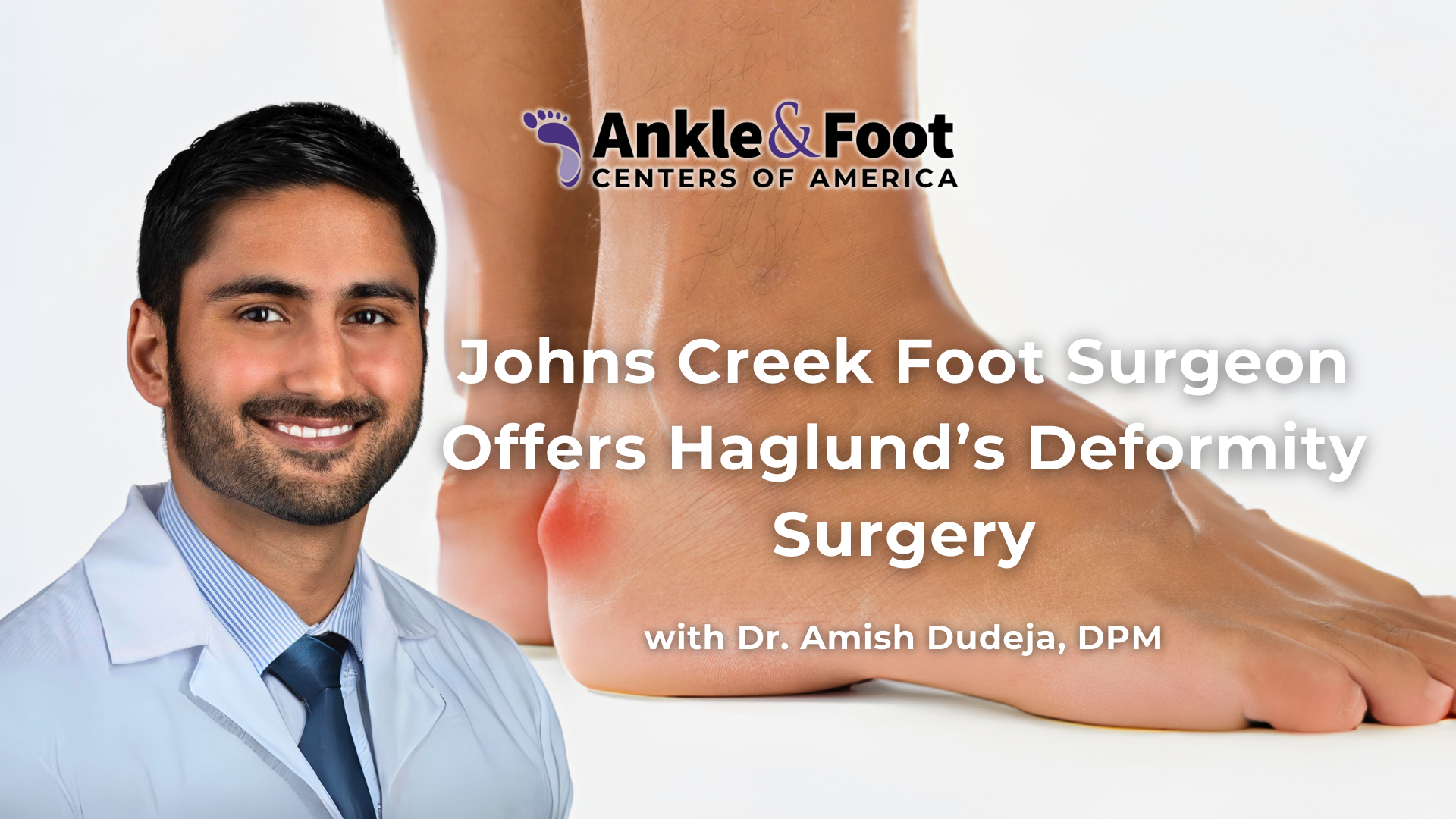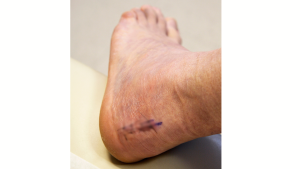Table of Contents
Introduction
Are you experiencing a painful lump on the back of your heel? If so, it could be Haglund’s deformity, a common yet frustrating condition. This bony enlargement often causes pain, swelling, and discomfort with every step. However, there’s good news! At our Johns Creek office, expert foot surgeons provide advanced Haglund’s deformity surgery to restore your comfort and mobility.
What is Haglund’s Deformity?
 Haglund’s deformity is a bony enlargement that forms at the back of the heel, near the Achilles tendon. This condition, often called a “pump bump,” develops when the bony prominence rubs against shoes, leading to irritation and inflammation.
Haglund’s deformity is a bony enlargement that forms at the back of the heel, near the Achilles tendon. This condition, often called a “pump bump,” develops when the bony prominence rubs against shoes, leading to irritation and inflammation.
Commonly, people with Haglund’s deformity experience symptoms like redness, swelling, and pain in the affected area. Over time, the constant friction can worsen these symptoms, making daily activities like walking or wearing shoes uncomfortable.
The condition is often linked to foot structure. For instance, high arches or tight Achilles tendons can increase the risk. Additionally, wearing rigid or poorly fitting footwear can aggravate the problem. Early identification and treatment can help manage symptoms effectively and prevent further complications.
Causes of Haglund’s Deformity
Haglund’s deformity develops due to repeated irritation and pressure on the back of the heel, leading to bony enlargement. Several factors contribute to this condition:
- Foot Structure
Individuals with certain foot shapes, such as high arches, are more prone to developing Haglund’s deformity. High arches increase pressure on the heel, exacerbating irritation. - Tight Achilles Tendon
A tight Achilles tendon pulls on the heel bone, creating tension and contributing to the formation of the bony prominence. - Improper Footwear
Wearing stiff or poorly fitting shoes, such as high heels or rigid backs, can rub against the heel, causing inflammation and irritation over time. - Repetitive Stress
Activities that involve repetitive motion, like running or prolonged walking, can increase strain on the heel, promoting the development of the deformity. - Genetics
A family history of Haglund’s deformity or similar foot conditions may also play a role in susceptibility.
Symptoms of Haglund’s Deformity
 Lump on the back of the heel: A bony bump that may become more prominent over time.
Lump on the back of the heel: A bony bump that may become more prominent over time.- Pain and discomfort: Particularly during or after wearing rigid or tight shoes.
- Swelling and redness: Inflammation around the affected area due to constant friction.
- Stiffness or limited movement: Difficulty in flexing the ankle or foot because of irritation and swelling.
- Blistering or callusing: Skin irritation from shoe pressure, often creating additional discomfort.
Pain Management for Haglund’s Deformity
While surgical treatment may eventually be necessary for severe cases, pain can often be managed effectively through these strategies:
- Wear Appropriate Shoes
Opt for soft, well-cushioned shoes with open backs or low heels to minimize pressure on the heel. - Apply Ice
Use ice packs on the swollen area for 15-20 minutes at a time to reduce inflammation and numb pain. - Use Heel Pads or Orthotics
Insert cushioned heel pads or custom orthotics into your shoes to protect the heel and reduce pressure. - Stretch Regularly
Perform stretches for the Achilles tendon and calf muscles to improve flexibility and decrease tension on the heel. - Take Anti-Inflammatory Medications
Use over-the-counter medications like ibuprofen to control pain and swelling effectively. - Limit Activities
Avoid repetitive activities like running or walking long distances that can exacerbate symptoms.
By following these pain management techniques, individuals can find relief and prevent symptoms from worsening. However, persistent discomfort should prompt consultation with a foot specialist to explore more advanced treatment options.

Treatment Options for Haglund’s Deformity
Haglund’s deformity can be treated through various non-surgical and surgical methods, depending on the severity of the condition. Early treatment often focuses on reducing pain and inflammation, while surgery is reserved for advanced cases.
Non-Surgical Treatment Options
- Proper Footwear
- Switch to soft, well-cushioned shoes with open backs or low heels to minimize friction.
- Avoid stiff or tight-fitting shoes, such as high heels, that aggravate the deformity.
- Orthotics and Heel Pads
- Use custom orthotics or heel lifts to reduce pressure on the affected area.
- Cushioned heel pads can also provide additional comfort and support.
- Ice Therapy
- Apply ice packs to the swollen area several times a day to reduce inflammation and pain.
- Physical Therapy
- Stretching exercises for the Achilles tendon and calf muscles can relieve tension on the heel.
- Strengthening exercises may improve foot alignment and reduce symptoms.
- Anti-Inflammatory Medications
- Over-the-counter medications like ibuprofen can help control pain and swelling.
- Immobilization
- In severe cases, wearing a walking boot or splint can rest the foot and promote healing.
Surgical Treatment: Haglund’s Deformity Surgery
When non-surgical treatments fail to relieve symptoms, surgery may be recommended.
- Goal of Surgery: Remove the bony enlargement, reduce pain, and restore mobility.
- Procedure: The surgeon may shave down or remove the excess bone, repair damaged tissues, and relieve tension on the Achilles tendon if necessary.
- Minimally Invasive Options: Some cases may qualify for less invasive techniques, resulting in faster recovery times.
Choosing the Right Treatment
The best treatment plan depends on the severity of your symptoms and your overall foot health. Early intervention with non-surgical methods can prevent the need for surgery. However, if pain persists or mobility is severely impacted, surgical intervention may be the best option for long-term relief.
Recovery from Haglund’s Deformity Surgery
Recovery from Haglund’s deformity surgery varies depending on the extent of the procedure and the individual’s overall health. Generally, patients can expect the following:
- Immediate Post-Surgery
- The foot is immobilized with a cast or boot to protect the surgical site.
- Pain and swelling are managed with prescribed medications and elevation.
- Weight-Bearing Restrictions
- Patients may need to avoid putting weight on the foot for a few weeks, using crutches or a knee scooter for mobility.
- Physical Therapy
- Gradual stretching and strengthening exercises help restore flexibility and mobility.
- Physical therapy typically begins a few weeks after surgery.
- Return to Normal Activities
- Most patients can resume light activities within 6-8 weeks, with a full recovery expected in 3-6 months.
- High-impact activities like running may require additional recovery time.
- Follow-Up Care
- Regular check-ups with your surgeon ensure proper healing and address any concerns.
Adhering to your post-operative care plan is crucial for a successful recovery and long-term relief from Haglund’s deformity.
Visual Guide to Haglund’s Deformity
Haglund’s deformity manifests as a noticeable bony bump on the back of the heel, where the Achilles tendon attaches to the calcaneus (heel bone). This enlargement can lead to irritation of surrounding soft tissues, causing pain and swelling.
Identifying Haglund’s Deformity:
- Location: The bony prominence is situated at the posterosuperior aspect of the calcaneus, just above the insertion point of the Achilles tendon.
- Appearance: Visually, it presents as a distinct bump on the back of the heel, which may become red and swollen due to inflammation.
- Associated Conditions: The deformity often leads to retrocalcaneal bursitis, an inflammation of the bursa located between the Achilles tendon and the heel bone.
Visual Representation:

Understanding Through Imaging:
- X-Rays: Radiographic images typically show a bony prominence on the posterosuperior aspect of the calcaneal tuberosity. Repeated trauma to this area can lead to loss of fat planes secondary to retrocalcaneal bursitis, which is also visible on X-rays.
- MRI: Magnetic Resonance Imaging is beneficial in detecting degenerative changes within the Achilles tendon and assessing the extent of any associated soft tissue involvement.
Clinical Significance:
Recognizing the visual and anatomical characteristics of Haglund’s deformity is crucial for accurate diagnosis and effective treatment planning. Early identification can lead to more conservative management options, potentially avoiding the need for surgical intervention.
Conclusion
Haglund’s deformity can be a painful and frustrating condition, but effective treatment options are available to help you regain your comfort and mobility. Whether you need guidance on non-surgical treatments or are considering surgery for lasting relief, our expert team in Johns Creek is here to help.
Don’t let heel pain hold you back any longer! Schedule a consultation with the skilled foot surgeons at Ankle & Foot Centers of America in Johns Creek today. Together, we’ll create a personalized plan to get you back on your feet and doing what you love.


 Lump on the back of the heel: A bony bump that may become more prominent over time.
Lump on the back of the heel: A bony bump that may become more prominent over time. When non-surgical treatments fail,
When non-surgical treatments fail, 



